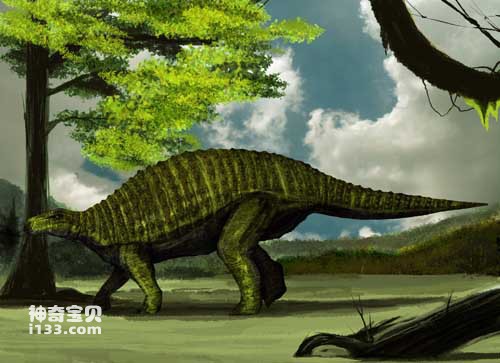Nodosaurus lived in the Late Cretaceous and was named by the famous paleontologist Marsh in 1889, meaning "nodulated lizard".
Nodosaurus is about 4 to 5 meters long and is mainly distributed in North America. The head and body of Nodosaurus were covered with tumor-like bony plates; nail-like protrusions were distributed on the sides of the body. There is no mallet at the tail end. Its back is arched, its body is round, its head is small, and its limbs are thick. But there are no erected bone plates on its back, and like other ankylosaurs, it is wrapped in thick bone fragments from head to tail. Its bone fragments are small and dense, much like the tracks of a tank. There are some small bony protrusions distributed regularly on these nail plates, as if there is a "bone blanket" covering the back. Although the backs of ankylosaurs were covered with bone armor, they had no sharp teeth in their mouths and mainly fed on young leaves and roots of plants.
What’s interesting is that Nodosaurus looks more like Stegosaurus, with an arched back, and it also walks on four legs, but its hind limbs are basically the same length as its forelimbs, with short and wide feet, and its head is larger than Stegosaurus. What is particularly different from Stegosaurus is that its body is not equipped with vertical sword plates, but wide and flat bone armor plates. These armor plates are densely distributed on the back of the body, and small bones protrude from each armor plate. sudden. The limbs and trunk of Nodosaurus were relatively strong and could bear the weight of the armor plates all over its body.
During the period when Nodosaurus was alive, there were many predators, the most famous of which was the notorious Tyrannosaurus rex. When the weak Nodosaurus encounters Tyrannosaurus, they usually lie down immediately and remain still. They do not have the bone hammer on the tail like Ankylosaurus. Only in this way can they effectively deal with large predators.
The nodosaur group represented by Nodosaurus is a unique member of the ankylosaurian family. People can easily distinguish them from other ankylosaurs, thanks to the fact that nodosaurs have characteristics that other ankylosaurs do not have: protruding bone spurs on the shoulders and neck. Of course, they did not have a club-shaped tail tip like other ankylosaurs.
The nodosaur group first appeared during the Albian period (the geological stage, the last stage of the Early Cretaceous, about 90 million to 112 million years ago), among which Scutosaurus is the most famous. Scutosaurus was a large nodosaur group, with fossils measuring approximately 5.5 meters in length.
The origin of the nodosaur group is generally believed to be somewhere in Europe, but there are still many disputes to be resolved in the paleontological community. There is evidence that nodosaurs and spiny ankylosaurs are the only ankylosaurian species that migrated across Europe. Most ankylosaurs do not have such living habits. Recent research has even revealed that wandering nodosaurs reached Antarctica through the Pampas region at the southern tip of South America.
The demise of the nodosaurs in South America was confirmed during the Maastrichtian (geological stage, the last stage of the Cretaceous, about 65 million to 71 million years ago), and the K/E boundary period before that , South American dinosaurs have begun to die out in large numbers. The extinction time of Arthropodosaurus in North America and Eurasia was basically the same.
Most nodosaur groups are accustomed to inhabiting lower coastal areas, although some species live in highland environments. Therefore, people have reason to believe that changes in sea level in the late Mesozoic Era may also be one of the reasons for their demise.

Chinese name: Nodosaurus
Latin name: Nodosaurus
Age of survival: Late Cretaceous
Fossil origin: North America, Wyoming, Kansas, USA
Physical characteristics: 4~6 meters long
Diet: plants
Species: Ankylosaur
Definition: lizard with nodes, nodes
animal tags: Nodosaurus
We created this article in conjunction with AI technology, then made sure it was fact-checked and edited by a Animals Top editor.